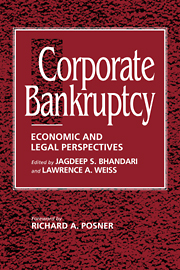Book contents
- Frontmatter
- Contents
- List of tables and figures
- Foreword by the HONORABLE RICHARD A. POSNER
- Preface
- Part I The role of credit
- Part II Bankruptcy as a reflection of the creditors' implicit bargain
- Part III Beyond the basic creditors' bargain
- Part IV Workouts or bargaining in the shadow of bankruptcy
- Part V Alternatives to bankruptcy and the creditors' bargain
- Part VI Experience of other countries
- 29 Lessons from a comparison of U.S. and U.K. insolvency codes
- 30 The costs of corporate bankruptcy: A U.S.–European comparison
- 31 Should we abolish Chapter 11? The evidence from Japan
- 32 The role of banks in reducing the costs of financial distress in Japan
- Index
29 - Lessons from a comparison of U.S. and U.K. insolvency codes
Published online by Cambridge University Press: 10 December 2009
- Frontmatter
- Contents
- List of tables and figures
- Foreword by the HONORABLE RICHARD A. POSNER
- Preface
- Part I The role of credit
- Part II Bankruptcy as a reflection of the creditors' implicit bargain
- Part III Beyond the basic creditors' bargain
- Part IV Workouts or bargaining in the shadow of bankruptcy
- Part V Alternatives to bankruptcy and the creditors' bargain
- Part VI Experience of other countries
- 29 Lessons from a comparison of U.S. and U.K. insolvency codes
- 30 The costs of corporate bankruptcy: A U.S.–European comparison
- 31 Should we abolish Chapter 11? The evidence from Japan
- 32 The role of banks in reducing the costs of financial distress in Japan
- Index
Summary
Introduction
This chapter describes two insolvency codes, those of the United Kingdom and the United States, and appraises their efficiency against a number of benchmarks.
The principles underlying the two systems differ in some fundamental respects. The main objective of chapter 11 of the 1978 U.S. Bankruptcy Code is to maintain the business as a going concern, even if that reduces the proceeds available to creditors. As a result, the Code has deliberately been designed to be highly debtor-oriented. Substantial rights are given to the board of the company to continue running the business while a reorganization plan is being constructed. In contrast, the main objective of the U.K. Code is the repayment of creditors' claims. As a result, the United Kingdom has had, at least prior to 1986, a highly creditor-oriented code. Under this Code, the company immediately comes under the control of an insolvency practitioner who represents the interests of creditors and, in some cases, only secured creditors. The concern expressed about the U.K. system has been that it reduces the value of the company by encouraging its premature liquidation. The introduction of administration in the 1986 Insolvency Act was designed to move the U.K. Code towards a debtor-type system; it is, therefore, sometimes referred to, incorrectly as we shall argue, as the U.K. equivalent of chapter 11.
International comparisons should be of interest on a number of accounts.
- Type
- Chapter
- Information
- Corporate BankruptcyEconomic and Legal Perspectives, pp. 450 - 466Publisher: Cambridge University PressPrint publication year: 1996
- 3
- Cited by



